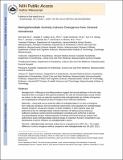Methylphenidate Actively Induces Emergence from General Anesthesia
Author(s)
Solt, Ken; Cotten, Joseph F.; Cimenser, Aylin; Wong, Kin F. K.; Chemali, Jessica J.; Brown, Emery N.; ... Show more Show less
DownloadBrown_Methylphenidate actively.pdf (1.382Mb)
OPEN_ACCESS_POLICY
Open Access Policy
Creative Commons Attribution-Noncommercial-Share Alike
Terms of use
Metadata
Show full item recordAbstract
Background: Although accumulating evidence suggests that arousal pathways in the brain play important roles in emergence from general anesthesia, the roles of monoaminergic arousal circuits are unclear. In this study, the authors tested the hypothesis that methylphenidate (an inhibitor of dopamine and norepinephrine transporters) induces emergence from isoflurane general anesthesia.
Methods: Using adult rats, the authors tested the effect of intravenous methylphenidate on time to emergence from isoflurane general anesthesia. They then performed experiments to test separately for methylphenidate-induced changes in arousal and changes in minute ventilation. A dose–response study was performed to test for methylphenidate-induced restoration of righting during continuous isoflurane general anesthesia. Surface electroencephalogram recordings were performed to observe neurophysiological changes. Plethysmography recordings and arterial blood gas analysis were performed to assess methylphenidate-induced changes in respiratory function. Intravenous droperidol was administered to test for inhibition of methylphenidate's actions.
Results: Methylphenidate decreased median time to emergence from 280 to 91 s. The median difference in time to emergence without methylphenidate compared with administration of methylphenidate was 200 [155–331] s (median, [95% CI]). During continuous inhalation of isoflurane, methylphenidate induced return of righting in a dose-dependent manner, induced a shift in electroencephalogram power from delta (less than 4 Hz) to theta (4–8 Hz), and induced an increase in minute ventilation. Administration of intravenous droperidol (0.5 mg/kg) before intravenous methylphenidate (5 mg/kg) largely inhibited methylphenidate-induced emergence behavior, electroencephalogram changes, and changes in minute ventilation.
Conclusions: Methylphenidate actively induces emergence from isoflurane general anesthesia by increasing arousal and respiratory drive, possibly through activation of dopaminergic and adrenergic arousal circuits. The authors' findings suggest that methylphenidate may be useful clinically as an agent to reverse general anesthetic-induced unconsciousness and respiratory depression at the end of surgery.
Date issued
2011-10Department
Harvard University--MIT Division of Health Sciences and Technology; Massachusetts Institute of Technology. Department of Brain and Cognitive SciencesJournal
Anesthesiology
Publisher
Ovid Technologies (Wolters Kluwer) - Lippincott Williams & Wilkins
Citation
Solt, Ken, Joseph F. Cotten, Aylin Cimenser, Kin F. K. Wong, Jessica J. Chemali, and Emery N. Brown. “Methylphenidate Actively Induces Emergence from General Anesthesia.” Anesthesiology 115, no. 4 (October 2011): 791–803.
Version: Author's final manuscript
ISSN
0003-3022